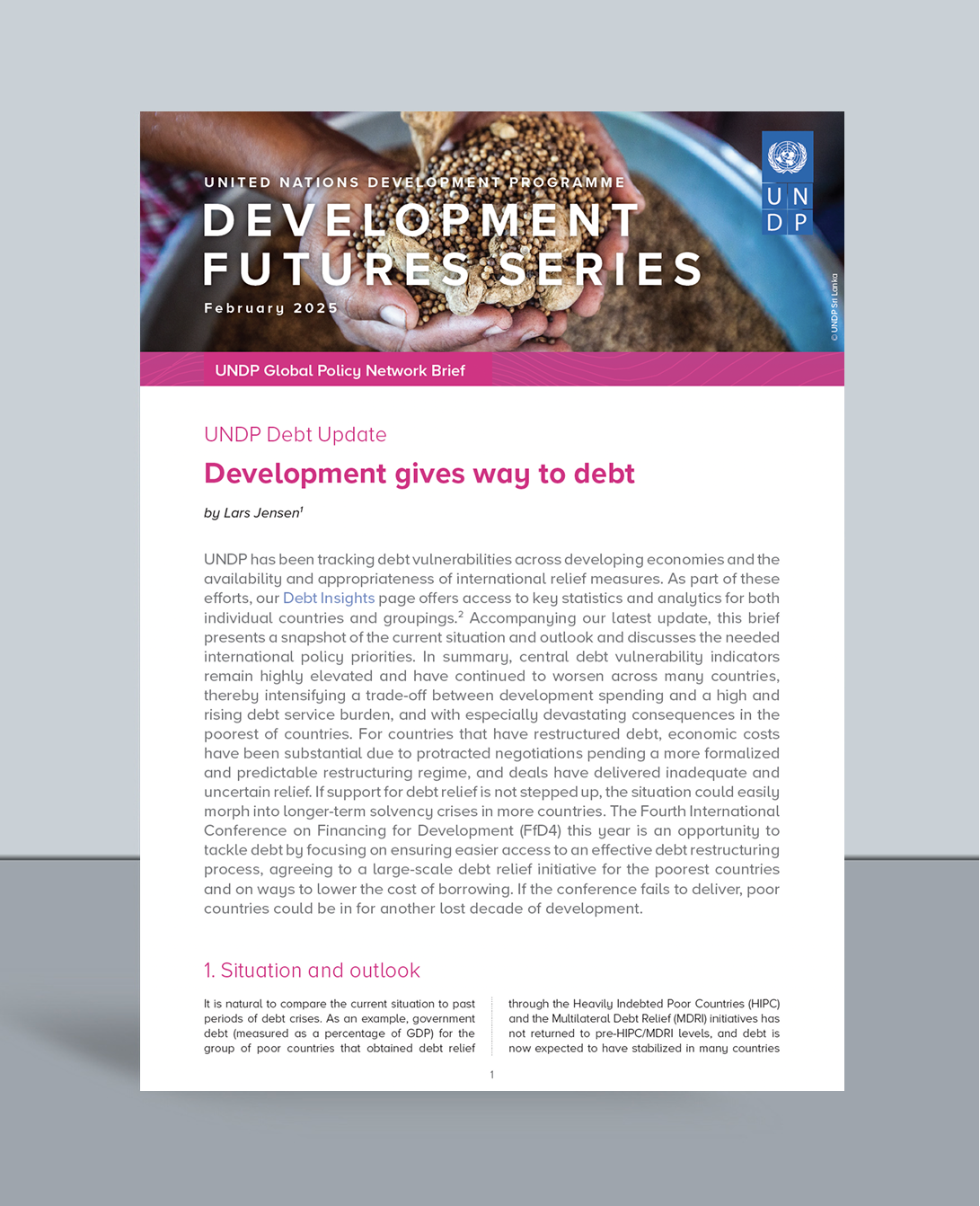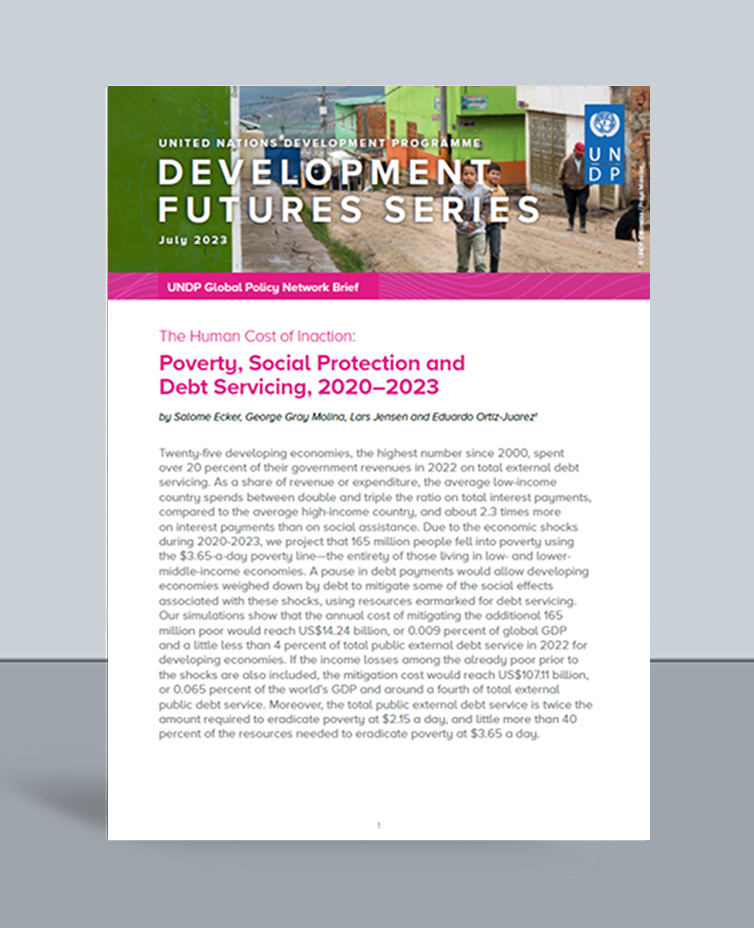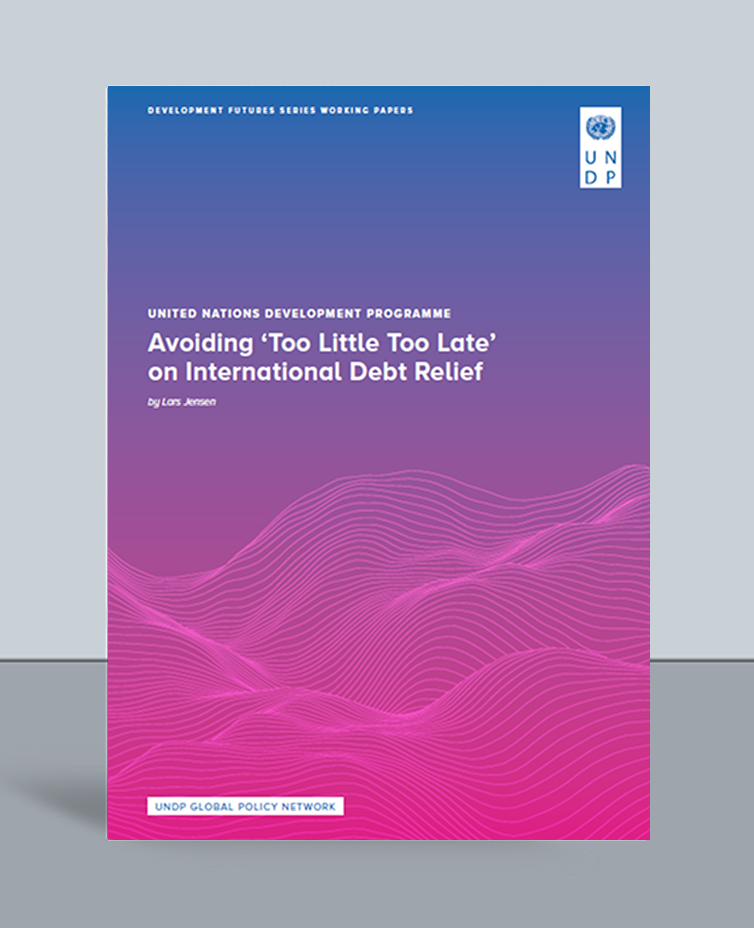Debt in developing economies
First published on 27 March 2024. Last update on 11 February 2025
Overview
For more than a decade, debt and debt service burdens have been rising across developing economies, and since the outbreak of COVID a record number of countries have been downgraded and entered into default and/or debt distress. For many countries, the current outlook looks highly precarious as they battle high levels of indebtedness, massive SDG (including climate) spending needs and a high cost of borrowing. For countries where debt burdens have either become too large to bear or with severe liquidity problems, a continued lack of access to effective debt restructuring and liquidity support in today’s complicated creditor and geopolitical landscape pose major constraints on their development prospects. For other countries, the debt crisis is “burning slower” with debt service payments consuming an ever-increasing share of revenue and expenditure and thereby crowding out much needed and urgent spending on education, health care, social protection and on dealing with climate change, etc.
What This Page Offers
*As defined by leading development institutions like the UN. Users can find details on the country groupings at the bottom of the page, and it should be noted that the platform does not cover high-income countries.
Key Numbers
Background
Debt servicing is crowding out development spending and jeopardizing the Paris Agreement
Over the past decade, public debt as a percentage of GDP has increased by about 20 percentage points in the median developing (low- and middle-income) economy, and debt servicing has been consuming an ever-increasing share of government revenue. For the median country, net interest payments as a share of revenue have more than doubled, and the number of countries that now pay more than 10 percent is 56, – 45 percent of countries with available data – up from 29 countries a decade ago. In twelve countries more than one quarter of revenue now goes toward interest payments.
Large external debt servicing needs create significant liquidity risk in some countries. The number of countries with total public external debt servicing higher than 20 percent of either revenue or exports has not been higher in more than two decades. For countries with a sovereign credit rating, 60 percent have a rating below ‘non-investment grade’ and for countries with debt assessed under the LIC-DSF1 52 percent are rated either in or at high risk of debt distress.
In short, current debt burdens coupled with inadequate access to effective debt restructuring and liquidity support and a high cost of borrowing contribute to a crowding out of crucial development spending. The World Bank has estimated that in IDA-eligible countries on average, total (domestic plus external) debt servicing in 2024 was higher than the combined public spending on health, education and infrastructure.2 UNDP has estimated that the average low-income country spends 2.3 times more on servicing net interest payments than on social assistance, 1.4 times more than on domestic health expenditures or 60 percent of what it spends on education.3 UN’s Global Crisis Response Group has estimated that in total, 48 countries are home to 3.3 billion people whose lives are directly affected by underinvestment in education or health due to large interest payments.4
By some estimates, emerging markets and developing economies (excl. China) will, in order to make meaningful progress on the SDGs broadly (including climate mitigation), need to increase annual spending by at least $3 trillion by 2030 (relative to 2019 levels).5 Adding SDG spending needs to expenditure projections is likely to send already high levels of public debt soaring in many countries, even under strong assumptions about private sector contributions, economic growth and revenue mobilization capacity.
Credit rating and debt distress (DSA) rating
Credit rating
Eighty-eight developing economies have an assigned sovereign credit rating by one or more of two major credit ratings agencies. Based on the average numerical rating across agencies, this figure shows the distribution of countries on ratings classes ranging from ‘Investment grade’ to ‘Default’. As an example, and for the category ‘All developing’ economies, 14 countries (16 percent) have an investment grade rating and 12 (14 percent) are considered in default.
Debt distress risk (DSA) rating
Sixty-seven developing economies have a debt distress rating from their debt sustainability analysis (DSA) carried out under the low-income country debt sustainability framework (LIC-DSF). As an example, and for the category ‘All developing’ economies, latest Debt Sustainability Analyses (DSAs) show that 52 percent of all countries assessed are now either 'In debt distress' (16 percent) or at 'High risk of debt distress' (36 percent).
Government debt
Over the past two decades and some, overall government debt levels (relative to GDP) in developing economies have undergone two major transformations. Average and median debt levels peaked around the early 2000s and fell steadily until around 2011 from where they started a steady ascent and then a shock during covid-19. This latest episode of increasing debt is referred to by some as the fourth wave of debt characterized by being exceptional in its size, speed and breadth1. As an example, and for the category ‘All developing’ economies, the median country had total government debt of 34 percent of GDP in 2011 compared to an estimated 56 percent in 2025. As for the external part of total debt (i.e. debt owed to nonresident creditors) this was 16 percent in 2011 for the median country compared to an estimated 26 percent in 2023 (latest available data point).
General government (net) interest payments
As with debt levels, the debt service burden has also been rising rapidly across developing economies over the last decade. As an example, and for the category ‘All developing’ economies, 56 countries (or 45 percent of countries with available data) now have estimated annual (net) interest payments of more than 10 percent of revenue up from 29 countries (23 percent) a decade ago. Twelve countries spend more than one-quarter of total revenue on net interest payments. Over the past decade, interest payments have been consuming an ever-increasing share of government revenue. The median country from the 'All developing' group is in 2025 expected to have net interest payments of 9.5 percent of total government revenue, - more than double the ratio from a decade earlier.
The World Bank has estimated that in IDA-eligible countries on average, total (domestic plus external) debt servicing in 2024 was higher than the combined public spending on health, education and infrastructure.2 UNDP has estimated that the average low-income country spends 2.3 times more on servicing net interest payments than on social assistance, 1.4 times more than on domestic health expenditures or 60 percent of what it spends on education.3 UN’s Global Crisis Response Group (GCRG) has estimated that in total, 48 countries are home to 3.3 billion people whose lives are directly affected by underinvestment in education or health due to large interest payments.4
External debt service
As for the overall debt burden, the burden of external debt servicing has similarly been rising steadily over the past decade and many developing economies are highly vulnerable to still tight external financing conditions. As an example, and for the category ‘All developing’ economies, it is estimated that in 2024, 26 countries had total (interest plus principal) debt payments on public and publicly guaranteed debt higher than 20 percent of total government revenue – which is 23 percent of countries (with available data). This year total debt servicing is expected to exceed 20 percent of revenue in 24 countries. Numbers this high have not been seen in more than two decades, and latest during the Heavily Indebted Poor Countries (HIPC) initiative. The same conclusion can be reached if looking at debt service relative to exports and primary income, even though data availability does not yet allow us to look beyond the year 2022.5
For the median ‘All developing' economy total external debt servicing on public and publicly guaranteed debt as a percentage of government revenue has gone from a low of 4 percent in 2011 to an estimated 11 percent this year. For the median Sub-Saharan African developing economy, total external debt servicing has gone from a low of 3 percent in 2011 to an estimated 14 percent this year.
External debt composition
The graph shows the debt composition of the external public and publicly guaranteed (PPG) debt stock in million (Mn) USD for the latest available year 2023 and on the four categories bilateral, multilateral, bonds and ‘other private’ creditors. As an example, the group 'All developing' economies owe 38 percent of debt to official (bilateral plus multilateral) creditors while this is much higher at 84 percent if only considering the 'Low income' group of countries. External debt composition matters a lot for countries' funding costs and can also be an indicator of how easy or difficult it might be for countries to reach agreement with creditors on debt relief when needed.
Publications
References
[1] Low Income Country Debt Sustainability Framework.
[2] IDA-eligible countries are low and select lower-middle income countries eligible for concessional lending from the World Bank. See World Bank blog ‘Urgent need to address liquidity pressures in developing economies’, January 24, 2024.
[3] See ‘The Human Cost of Inaction: Poverty, Social Protection and Debt Servicing, 2020-2023’, July 14, 2023.
[4] See ‘A world of debt – A growing burden to global prosperity’.
[5] See From MDB Evolution to Transformation: Volume 2 of the IEG Report
[6] See Global Tipping Points Report 2023.
[1] See ‘What Has Been the Impact of COVID-19 on Debt? Turning a Wave into a Tsunami’, the World Bank, November 2021.
[2] IDA-eligible countries are low and select lower-middle income countries eligible for concessional lending from the World Bank. See World Bank blog ‘Urgent need to address liquidity pressures in developing economies’, January 24, 2024.
[3] See ‘The Human Cost of Inaction: Poverty, Social Protection and Debt Servicing, 2020-2023’, July 14, 2023.
[4] See ‘A world of debt – A growing burden to global prosperity’.
[5] Note here that the drop in debt service ratios in 2022 is likely due to the temporary debt relief (postponement of payments) provided under the now expired Debt Service Suspension initiative (DSSI).
[6] For the latest DSA ratings visit: https://www.imf.org/external/Pubs/ft/dsa/DSAlist.pdf
Supplementary Data
We show summary statistics for groups commonly used by various development partners including UN/UNDP classifications, - but exclude all ‘High Income’ countries (as per the World Bank’s income classification).
| Name | Abbreviation | Description | Source | Link |
|---|---|---|---|---|
| All developing | DE | Developing economies defined as all low- and middle-income countries. | As per World Bank income group classification | Learn more |
| Low income | LIC | Low income countries | Ibid | |
| Lower-middle income | LMC | Lower-middle income countries | Ibid | |
| Upper-middle income | UMC | Upper-middle income countries | Ibid | |
| Middle income | MIC | Middle income countries | Ibid | |
| Least developed | LDC | Least developed countries | As per UN classification | Learn more |
| Small island developing | SIDS | Small Island Developing States | As per UN classification | Learn more |
| Landlocked developing | LLDC | Landlocked developing countries | As per UN classification | Learn more |
| Emerging market | EM | Emerging market economy | As per IMF’s Fiscal Monitor classification | Learn more |
| Low income developing | LIDC | Low income developing country | As per IMF’s Fiscal Monitor classification | Learn more |
| Poorest | Poorest | The term ‘poorest countries’ is often used to refer to the group of countries eligible for IDA funding from the World Bank | IDA eligible countries | Learn more |
| Heavily indebted poor | HIPC | HIPC countries are countries that have reached the post-completion point of the HIPC initiative first launched in 1996. | HIPC eligible countries | Learn more |
| Very high human development | Very high HDI | Ranking of countries based on their Human Development Indicator (HDI) score | UNDP Human Development Report | Learn more |
| High human development | High HDI | Ranking of countries based on their Human Development Indicator (HDI) score | UNDP Human Development Report | Learn more |
| Medium human development | Medium HDI | Ranking of countries based on their Human Development Indicator (HDI) score | UNDP Human Development Report | Learn more |
| Low human development | Low HDI | Ranking of countries based on their Human Development Indicator (HDI) score | UNDP Human Development Report | Learn more |








